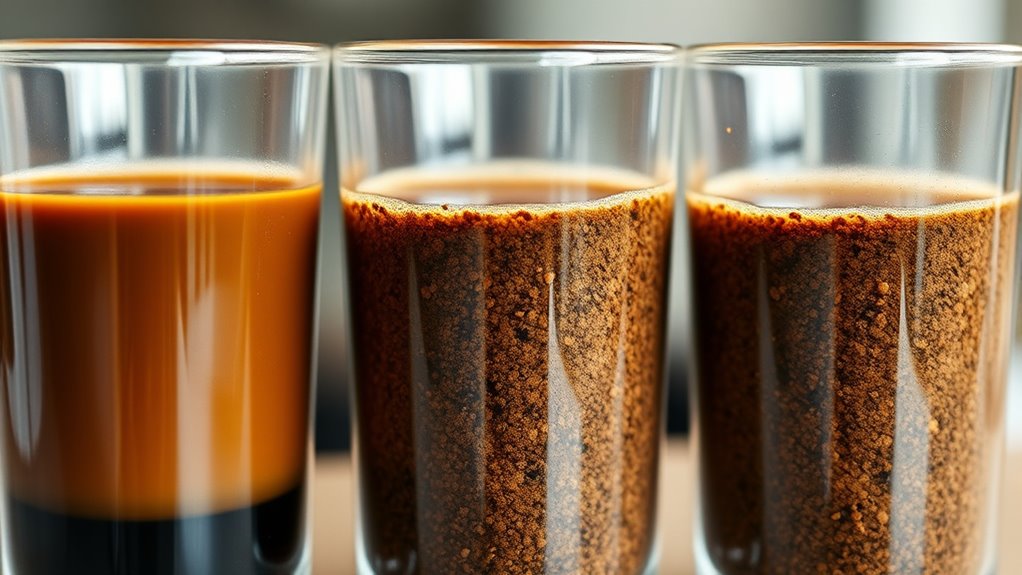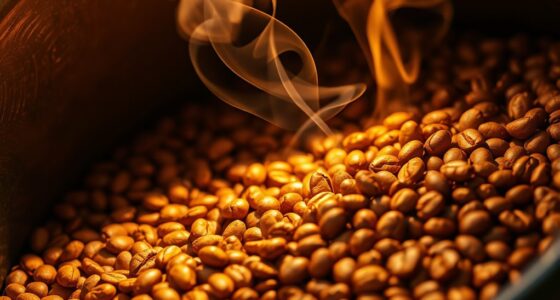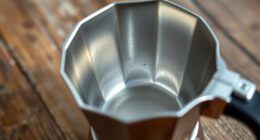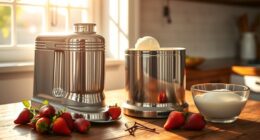Your grind size greatly impacts your coffee’s flavor by controlling extraction and particle interaction. Finer grinds increase surface area, leading to stronger, brighter flavors but risk bitterness if over-extracted. Coarser grinds produce a fuller body with less acidity but may weaken taste if too coarse. Matching your grind to your brewing method ensures balanced flavor. Keep exploring how adjusting grind size can perfect your brew and reveal new flavor possibilities.
Key Takeaways
- Finer grinds increase surface area, leading to faster extraction and stronger, more intense flavors.
- Coarser grinds slow extraction, resulting in a lighter, more delicate flavor profile.
- Overly fine grind can cause over-extraction, bitterness, and undesirable astringency.
- Coarser grounds produce a clean, full-bodied cup with less sediment and acidity.
- Matching grind size to brewing method and roast level optimizes flavor clarity and balance.
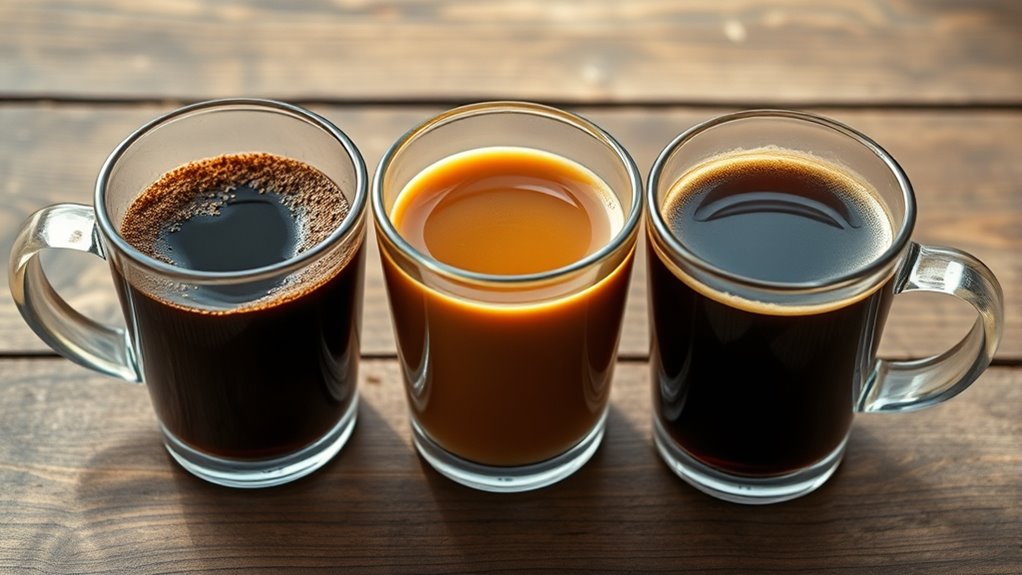
Choosing the right grind size is essential because it directly influences the flavor and strength of your coffee. When you grind coffee beans, you’re creating particles of varying sizes, which affects how water interacts with the grounds during brewing. The surface area exposed to water plays a vital role—finer grinds have more surface area, enabling faster extraction of flavors, oils, and compounds.
Choosing the right grind size directly impacts your coffee’s flavor, strength, and extraction quality.
This means that if your grind is too fine for your brewing method, you might over-extract, leading to bitterness and a harsh taste. Conversely, if your grind is too coarse, extraction may be insufficient, resulting in a weak or sour brew.
The variation in grind size ranges from extra coarse to extremely fine, and selecting the appropriate one depends on your brewing method. For quick methods like espresso or pour-over, a finer grind allows water to pass through quickly, providing a controlled and precise extraction. Espresso, in particular, uses an extra fine grind because high pressure extracts oils rapidly, producing a rich, concentrated shot.
On the other hand, longer brewing methods like cold brew or French press benefit from coarser grounds. They allow flavors to develop slowly over extended steeping times without becoming overly bitter or muddy from too much extraction.
Your roast level also influences how you should grind. Dark roasts tend to be more brittle, so they often require slightly coarser grinds to prevent over-extraction. Light roasts, with their denser structure, may need finer grounds to *access* delicate flavors during brewing. Medium roasts strike a balance, adapting well to a variety of grind sizes.
Remember, the goal is to match the grind size with your brewing equipment and process. For example, drip coffee makers usually work best with medium grinds, while percolators and French presses call for coarser textures.
Flavor profiles are deeply affected by your choice of grind size. Coarser grounds tend to produce a full-bodied, clean cup with less sediment, emphasizing body and mouthfeel. Finer grounds enhance acidity and brightness but risk over-extraction, which can make your coffee bitter.
The key is to experiment—*adjusting* your grind to find the perfect balance that complements your roast level and personal taste preferences. When you understand how grind size influences extraction, you gain control over your coffee’s flavor, aroma, and strength, allowing you to craft the ideal cup every time.
Additionally, consistent grind size is vital for achieving predictable results and optimal flavor extraction.
Frequently Asked Questions
How Does Grind Size Affect Brewing Time?
You might wonder how grind size affects brewing time, and it’s simple: a coarser grind requires longer brewing because it has less surface area, slowing extraction.
Conversely, a finer grind speeds up brewing since it exposes more surface area to water. Adjusting grind size lets you control extraction, ensuring your coffee isn’t under- or over-extracted, which ultimately influences the flavor and strength of your brew.
Can Grind Size Influence Caffeine Extraction?
Yes, grind size can influence caffeine extraction. When you use a finer grind, you increase the surface area, allowing water to extract caffeine more quickly and efficiently.
Conversely, coarser grinds slow down caffeine release, leading to potentially less caffeine in your brew. Your brewing method also matters, but selecting the right grind size helps optimize caffeine extraction, giving you a stronger or milder coffee as desired.
Does Grind Size Impact Coffee Acidity Levels?
Yes, grind size considerably impacts coffee acidity levels. When you use a coarser grind, you may notice higher acidity if the extraction isn’t overdone, but it can also cause sharp, unbalanced flavors.
Finer grinds tend to produce a more balanced acidity because they extract faster. Adjusting your grind size based on brewing method and personal taste allows you to control the acidity, ensuring your coffee tastes just right.
How Should Grind Size Vary for Different Brewing Methods?
Imagine your coffee’s flavor as a symphony, each element needing the right instrument. For different brewing methods, you should modify your grind size like tuning those instruments.
Use a very fine grind for Turkish coffee and espresso. Medium-fine is suitable for pour-over. Coarse grind works best for French press.
This guarantees water flows just right, extracting flavors perfectly—like a harmonious melody. Each method highlights different notes in your coffee.
Can Inconsistent Grind Size Ruin Coffee Flavor?
Yes, inconsistent grind size can ruin your coffee flavor. When your grind isn’t uniform, you’ll get both over-extracted and under-extracted particles, leading to a muddled taste with bitterness, sourness, and a flat body.
This unpredictability makes it hard to achieve a balanced brew. To prevent this, use quality grinders, calibrate them properly, and consider sieving to guarantee uniform particles, which results in better extraction and flavor clarity.
Conclusion
By now, you see how grind size shapes your coffee’s flavor. Using a medium grind can enhance clarity, while a finer grind boosts body. Did you know that baristas report that adjusting grind size can improve brew consistency by up to 30%? So, next time you brew, experiment with grind sizes to find your perfect cup. Small changes really can make a big difference in your coffee experience.
